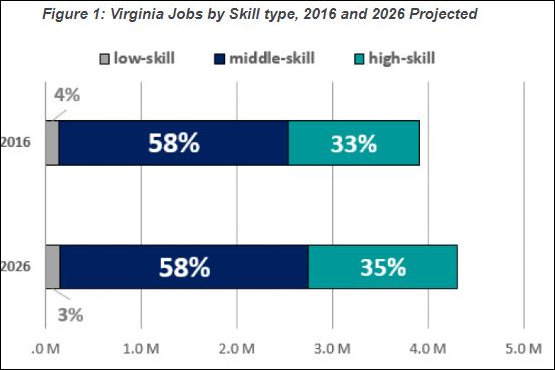True, employers are putting an increasing emphasis on technical skills. But 58% of all Virginia jobs in 2016 were classified as “middle-skill,” which usually can be supplied by community colleges and career schools, and the percentage still will be 58% by 2026, according to Virginia Employment Commission forecasts cited by the Demographics Research Group at the University of Virginia.
As total employment increases, the number of middle-skill jobs will increase by 200,000 in Virginia, reports Spencer Shanholtz in the StatChat blog. The percentage of low-skill jobs will decrease from 4% to 3% over that 10-year period, while the percentage of high-skill jobs will increase from 33% to 35%.
Exploring the public-policy implications, Shanholtz writes: “It would be sensible to increase attention towards “Middle-skill” pathways, which can provide gainful employment and encourage further education and degree completion.”
High-growth middle-skill occupations are dominated by the health care sector. They include personal care aides, home health aides, physical therapist assistants, medical assistants, and occupational therapy assistants. While some occupations are low-paying, the 2017 annual median wage in Virginia was $60,940 for physical therapist assistants and $66,520 for occupational therapy assistants. Salaries could well rise for some of these categories, which are expected to see shortages nationally.
“The ability of the U.S. Education system to develop midlevel skills is deficient,” says Shanholtz. “Education and workforce systems are failing to keep pace with the changing needs of the economy, and employers are struggling to find skilled workers. The demand is there, but obviously, the supply is lacking.”
Preparation for middle-skill jobs has been traditionally through community college education, associates degrees, apprenticeships, or on-the-job training. Options have expanded to include education at for-profit colleges, certificates, certifications, badges, coding and technology boot camps, course clusters, and career and technical education (CTE) programs that start in high school and extend into community colleges. …
A certificate is the highest form of education held by about 1 in 10 American workers and certificate holders earn 20 percent more than workers who hold only a high school diploma. In 2017, Virginia as a whole awarded just over 20,000 certificates with rates being highest in the rural areas of the state.
Bacon’s bottom line: At at time when a four-year college education remains unaffordable for many (even though Virginia’s public four-year colleges are freezing tuition this academic year), middle-skill degrees and certificates look like an increasingly practical path toward a middle-class income.
The State Council of Higher Education for Virginia (SCHEV) recognizes the value of middle-skill degrees, but public perception does not appear to have caught up with marketplace realities. Many students pursue four-year degrees only (a) to drop out after racking up significant debt or (b) graduate but settle for jobs that don’t require a B.A. degree.
The cultural bias in favor of a four-year degree and a white-collar profession is powerful. But eventually, the high cost and low economic returns of many four-year college degrees will tell. Prestigious programs in technology and engineering will continue to draw Virginia’s research institutions like bees to honey. Hopefully, the commonwealth’s other institutions of higher education will keep up with the demand for middle-skill occupations.



